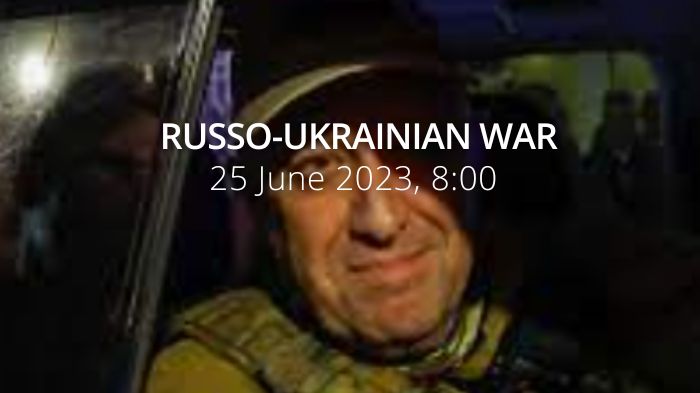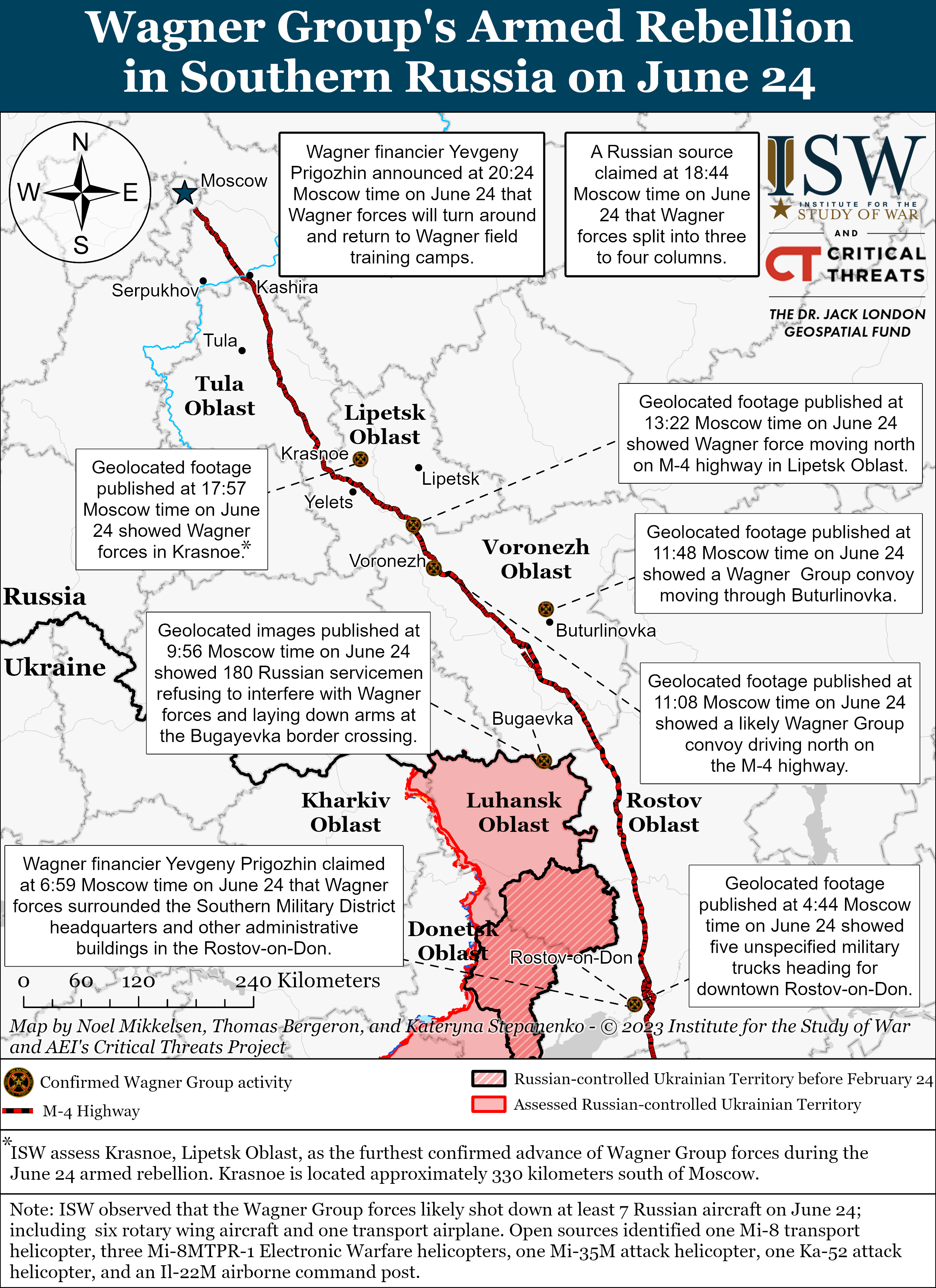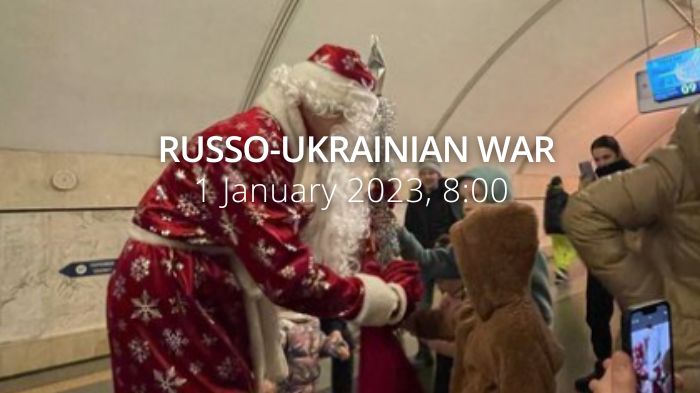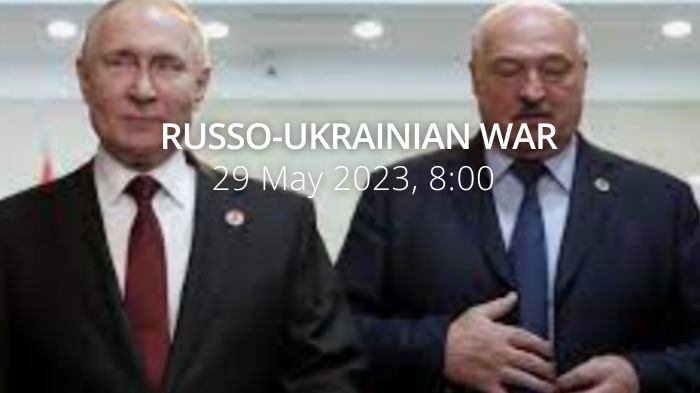Ukraine liberates the area near Donetsk occupied since 2014 and starts offensive in Bakhmut. Russian night air attack kills at least three as Ukraine downs 41 of 51 cruise missiles. The implications of the Lukashenko-Prigozhin deal for the leadership of the Russian Ministry of Defense remain ambiguous.
Wagner chief Prigozhin planned mutiny in Russia since mid-June – Washington Post
Daily overview — Summary report, June 25

The General Staff’s operational update regarding the Russian invasion as of 18.00 pm, June 25, 2023 is in the dropdown menu below:


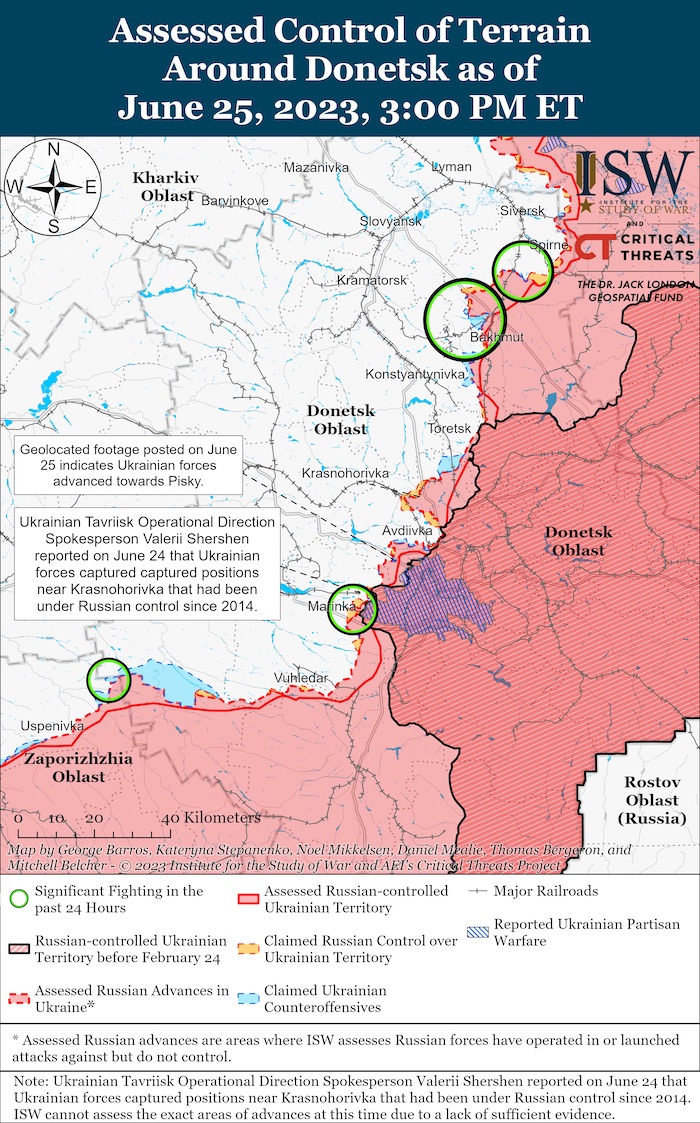
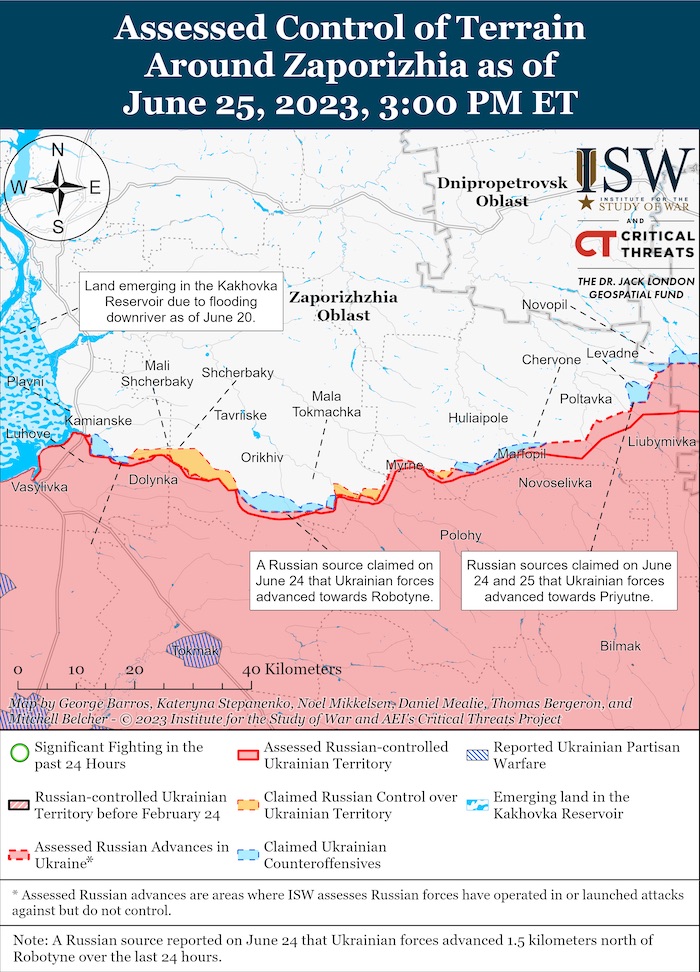

Military Updates
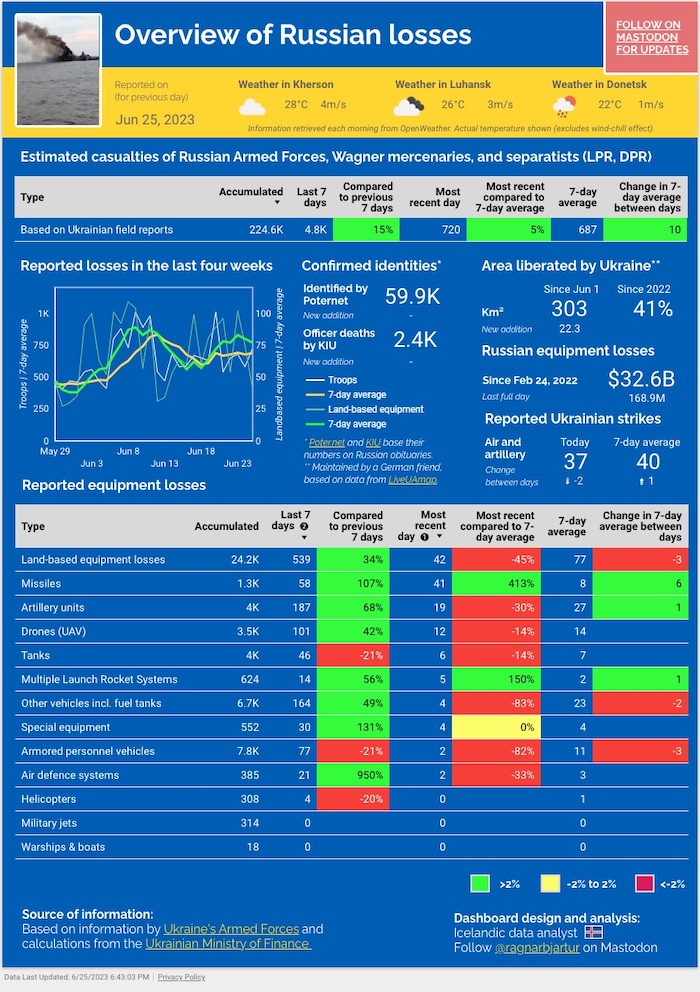
Ukraine starts offensive in Bakhmut area in several directions at once – Defense Ministry. Ukraine’s Deputy Defense Minister Hanna Maliar says that on 24 June, Ukrainian troops started an offensive in several directions in the country’s east at once as fighting continues in the south. All settlements mentioned as directions of the offensive are located in the area of Bakhmut City. “Today, the Eastern Group of Forces launched an offensive in several directions simultaneously, in the directions of Orikhovo-Vasylivka, Bakhmut, Bohdanivka, Yahidne, Klishchiyivka, Kurdiumivka. There is progress in all directions,” Maliar wrote.
Ukraine liberates the area near Donetsk occupied since 2014, the military confirms. The Ukrainian Defense Forces have officially confirmed the liberation of an area near Krasnohorivka southwest of Donetsk, which had been under Russian control since 2014. According to the military, the Ukrainian troops drove out the occupiers about a week ago, but the information was not made public for tactical reasons, Suspilne reported. The news reports about the liberation of a 0,51 square kilometer area near Donetsk City emerged in the Ukrainian media on 22 and 23 June.
According to British Defence Intelligence, (last 48 hours):
In recent days, Ukrainian forces have re-set and have again been undertaking major offensive operations on three main axes in southern and eastern Ukraine.
Ukrainian forces are using the experiences from the first two weeks of the counter-offensive to refine tactics for assaulting the deep, well prepared Russian defences. Ukrainian units are making gradual but steady tactical progress in key areas.
Losses of the Russian army

Humanitarian
Russian night air attack kills at least three as Ukraine downs 41 of 51 cruise missiles. Overnight into 24 June, Russians launched a massive missile attack against Ukraine with air-launched cruise missiles from Tu-95MS, Tu-22M3 aircraft, sea-based Kalibr [missiles], and Shahed-136/131 attack drones. According to Ukraine’s Air Force Command, Russia launched a total of 51 missiles and two Shahed one-way attack drones, and Ukrainian air defenses destroyed 41 missiles and both Shaheds. The Air Force says the attack comprised:
- 40 Kh-101/Kh-555 cruise missiles launched by 10 Russian strategic aviation aircraft from the Caspian Sea.
- 9 Kh-22 missiles launched by 8 Tu-22M3 long-range bombers from the northern, southern, and eastern directions.
- two Kalibr sea-based cruise missiles fired from the Black Sea.
- 2 Iranian Shahed-136/131 attack drones launched from the south.
“Dramatic detective story”: Ukraine repatriates three POWs from Hungary. Eight are left
Environmental
Wagner coup intended to seize nuclear weapons depots – partisan movement. The Ukrainian-Crimean Tatar partisan movement Atesh claims the Wagner PMC has set its eyes on “375 Object ‘C’” near Borisoglebsk, Voronezh Oblast, corroborating earlier reports by the Gulagu.net human rights group. Atesh, a partisan movement of Ukrainians and Crimean Tatars that claims to have ensnared many agents within the Russian Army into its ranks, claims that the PCM Wagner, engaged in an armed rebellion against the Russian authorities, is preparing to seize nuclear weapons depots in Voronezh Oblast.
Wagner coup was months in the making, Russia’s loss of nuclear control possible – Gulagu.net. The Russian human rights group Gulagu.net, which started by investigating torture in Russian prisons and during Russia’s full-blown invasion of Ukraine earned fame for sharing information from Russian insiders, states that PMC Wagner’s armed rebellion was an operation planned since autumn 2022, and that an operation to seize Russian strategic nuclear weapons sites is unfolding.
New Developments
Moscow braces as Wagner PMC approaches the Russian capital. The Russian online media Vyorstka has mapped the march of Yevgeny Prigozhin and the Wagner PMC on Moscow, which we have translated. The data on the map is as of 16:30 Moscow time. Since its publication, there have been sporadic reports that Wagner is approaching Moscow Oblast, such as Igor Girkin, instrumental to Russia’s occupation of Crimea and eastern Ukraine in 2014, who wrote that Wagner reached Barabanovo village, two hours from Moscow. According to Vyorstka, the mercenary forces were divided into two groups, which crossed the border between Russia and Russian-occupied Ukraine in two places.
Prigozhin stops Wagner forces 200 km away from Moscow, says they return to field camps. In a voice message published on his Telegram channel, Yevgeny Prigozhin, the owner of Wagner Group, announced that he ordered his forces to return to their field camps, as they were only 200 kilometers away from reaching Moscow. “They wanted to disband the Wagner PMC. We set out on 23 June on a justice march. Within a day, we marched just short of 200 km from Moscow. During that time, we have not shed a single drop of blood of our fighters. Now the moment has come when blood can be spilled, so, realizing all the responsibility for the fact that Russian blood will be spilled on one side, we are turning our columns around and leaving in the opposite direction to the field camps, according to the plan,” Prigozhin stated.
Pro-Ukraine Russian units supported Prigozhin’s coup in Russia. Two pro-Ukrainian units formed of Russian citizens, the Russian Volunteer Corps (RDK) and the Russia Freedom Legion (LSR), supported the Wagner Group’s coup against the Russian authorities, and called on their supporters to take action. The Russia Freedom legion wrote on Telegram, “Prigozhin is our enemy on the battlefield, but now he is telling the truth: about how cowardly generals send hundreds of thousands of Russians to their deaths as cannon fodder.
Putin is barricading himself against those he armed – Zelesnkyy on Prigozhin’s mutiny. Ukraine’s President Volodymyr Zelenskyy commented on the mutiny of Wagner Group’s owner Yevgeny Prigozhin against Russia’s leadership, saying that Russian President Vladimir Putin is now barricading himself in Moscow against those he himself armed. According to the Ukrainian president, Putin sent the invaders to destroy another country but failed to keep them from fleeing and betraying.
Putin tried to negotiate with Prigozhin, unsuccessfully – Russian media. The Kremlin had tried to reach an agreement with Wagner financier Yevgeny Prigozhin when the latter announced a “march for justice” after claims that Russia turned on his mercenaries. However, Wagner rejected Russian President Putin’s conditions and afterward, the FSB opened a criminal case against Prigozhin, the Russian media Vazhnye Istorii writes, citing its sources in the Russian Presidential Administration. “The Kremlin tried to negotiate with Prigozhin yesterday. He received a call from the President’s Administration (not Putin) suggesting that he should back off and that all of his reports should be explained as hacking and voice falsification,” a source close to the presidential administration told the media.
Assessment
- On the war.
The Institute for the Study of War has made the following assessment as of June 24, 2022:

Russian sources speculated on the specifics of the deal mediated by Belarusian dictator Alexander Lukashenko to end the Wagner Group’s June 23-24 armed rebellion, including the possible involvement of Russian President Vladimir Putin’s chief of staff. Russian opposition outlet Meduza, citing unnamed internal Kremlin sources, reported that Prigozhin initially tried to get in touch with the Russian Presidential Administration midday June 24 as Wagner fighters moved north from Rostov-on-Don towards Moscow, but that Putin refused to speak with Prigozhin.[1] Meduza noted that, once Prigozhin observed the lack of widespread military support for Wagner’s actions and changed his mind on Wagner’s prospects, the Kremlin turned to negotiations involving Lukashenko, Chief of Staff of the Russian Presidential Office Anton Vaino, and Russian Ambassador to Belarus Boris Gryzlov. Vaino and Gryzlov’s possible involvement was not reported on June 24. A prominent Kremlin-affiliated milblogger also questioned whether the deal will hold Wagner or Prigozhin accountable in any way for the deaths of at least 13 Russian airman on June 24.[2] Prigozhin’s whereabouts cannot be verified beyond his departure from Rostov-on-Don late on June 24. Russian outlet RTVI claimed that Prigozhin’s press service told RTVI that Prigozhin “sends his regards” and will answer all questions “when he is on normal communication,” and a prominent Wagner-affiliated Telegram channel shared an AI-generated image of Prigozhin holding a finger to his lips and stating “plans love silence,” a copy of the phrase commonly used in Ukraine about operational security.[3] As ISW noted on June 24, the specifics of the deal are still unclear in the open source beyond speculation and rumor. The fallout of Wagner’s armed rebellion has not yet concluded, and it remains to be seen how the deal will be implemented, if all involved parties will comply fully, how the Kremlin and Russian Ministry of Defense (MoD) intend to do with Wagner personnel – and if Wagner fighters will cooperate, regardless of Prigozhin’s wishes.
The implications of the Lukashenko-Prigozhin deal for the leadership of the Russian MoD also remain ambiguous. Some Russian sources, including internal Kremlin sources cited by Meduza, suggested that the Kremlin may be considering changes to MoD leadership as part of the deal.[4] Russian Defense Minister Sergei Shoigu and Chief of the General Staff Army General Valery Gerasimov have not been seen or heard from since before Prigozhin announced the beginning of the armed rebellion on June 23. Some Russian sources suggested that Alexei Dyumin, the current governor of Tula Oblast, former security officer to Putin, and former head of Russia’s Special Operations Forces, may replace Shoigu as the Defense Minister, although ISW cannot confirm these speculations.[5] Any changes to the MoD leadership would notably represent a significant victory for Prigozhin, who justified his armed rebellion by directly accusing Shoigu and Gerasimov of the deaths of tens of thousands of Russian soldiers in Ukraine.[6]
Wagner forces continued to withdraw from positions in Rostov and on the road to Moscow to their bases on June 25, and the Kremlin’s intended structure for leveraging Wagner fighters remains unclear. Geolocated footage published on June 25 shows armed Wagner forces driving south away from Moscow near Voronezh City.[7] Footage published on June 25 purportedly shows Wagner forces returning to training camps in southern Russia.[8] The fact that Wagner is returning to their training camps with military equipment indicates that the Kremlin intends to maintain at least certain elements of Wagner’s manpower rather than seek to immediately demobilize them, although the future of Wagner’s command and organizational structure are unclear. Russian State Duma Defense Committee Head Andrei Kartapolov announced on June 25 that the State Duma is working on a law that would regulate private military companies (PMCs) but emphasized that it is not necessary to ban the Wagner Group as it is “the most combat-ready unit in Russia.”[9] Kartapolov further noted that the future of the Wagner Group is undetermined and emphasized that the personnel of the Wagner Group in Rostov-on-Don were “following orders of their command” and “did nothing reprehensible.”[10] Kartapolov’s efforts to absolve Wagner personnel of responsibility for taking part in an armed rebellion and separate them from Prigozhin may indicate the Russian government’s desire to continue to use Wagner personnel in some capacity, and as ISW assessed on June 24, the Russian leadership could redeploy Wagner to Ukraine or instead commit them to international missions. Russian state-affiliated news outlets reported on June 24 that the Russian Federal Service for Supervision of Communications, Information Technology and Mass Media (Rozkomnadzor) blocked Prigozhin’s official press service on Russian social media site VKontakte, indicating the Kremlin’s efforts to restrict Prigozhin’s organizational actions.[11]
Further details emerged on the composition of the Wagner units approaching Moscow on June 24, indicating Prigozhin would likely have struggled in an active conflict in Moscow without additional support. Russian sources claimed on June 25 that the first Wagner column that began moving towards Moscow on June 24 consisted of 350 pieces of equipment, including nine tanks, four Tigr infantry fighting vehicles, a Grad MLRS system, and a howitzer.[12] Russian sources claimed that the three other Wagner columns that moved towards Moscow had 375, 100, and 212 pieces of equipment respectively, the majority of which were non-armored trucks, cars, and buses.[13] Russian milbloggers claimed on June 24 that the columns moving towards Moscow were comprised of 4,000 personnel with 40 to 50 pieces of equipment, including MRAPs, T-90M main battle tanks, BMP infantry fighting vehicles, Pantsir air defense systems, and Grad MLRS systems.[14] CNN reported on June 24 that US and Western intelligence officials observed Wagner amassing equipment and ammunition for the rebellion for several weeks, indicating that the columns likely comprised Wagner‘s greatest available strength.[15] ISW cannot confirm the exact composition of the Wagner columns at this time, although current reporting suggests that Prigozhin’s force would have struggled to fully occupy Moscow or conduct prolonged engagements with elements of the Russian Armed Forces, if they deployed. ISW previously assessed that Prigozhin likely sought and failed to win military support for his rebellion, and Wagner’s move on Moscow was likely predicated on the assumption that military support would strengthen the rebellion’s forces and capabilities.[16] Prigozhin may have become more amenable to the alleged negotiations with Lukashenko as these insufficient forces drew nearer to Moscow and that time was running out to garner the necessary military support for a potential armed conflict with the MoD.
The Russian ultranationalist information space fractured on June 25 between those who want to move past the rebellion and those demanding solutions to the internal security flaws that the rebellion had exposed. A Wagner-affiliated milblogger praised all of the parties for bringing the rebellion to an end and avoiding bloodshed, ignoring the fact that Wagner forces killed at least 13 Russian pilots and airmen during the rebellion.[17] Other Russian sources continued to characterize the rebellion as solely Prigozhin’s doing and called on Russian authorities to show clemency towards the Wagner fighters who have fought for Russian interests in Ukraine.[18] A Russian milblogger specifically accused Moscow Oblast officials and the MoD of failing to stop the Wagner advance towards Moscow.[19] The milblogger questioned how the MoD would be able to respond to external incursions if it was unable to stop Wagner’s movement towards Moscow.[20] A former Russian occupation official criticized how the internal Russian structures were slow in publicly addressing the rebellion.[21] Several other Russian milbloggers criticized the Russian elites for failing to publicly support Putin and for fleeing Russia.[22] Another Russian ultranationalist bemoaned that Prigozhin’s rebellion indicated that Russia is one step closer to its final and irrevocable death.[23] A prominent milblogger asked how Russian authorities will punish those involved in the deaths of Russian servicemen, indicating that clemency for the Wagner fighters that participated in the rebellion may become a longstanding grievance for elements of the Russian military and the ultranationalist community.[24]
The ultranationalist Angry Patriots Club held a pre-scheduled event in Moscow on June 25 and espoused longstanding criticisms against Putin and the Russian military leadership, suggesting that the Kremlin will not immediately begin cracking down on antagonistic ultranationalist groups in the aftermath of Prigozhin’s rebellion.[25] The Angry Patriots Club is a pro-war social movement that aims to correct perceived issues in the war-effort in Ukraine so that Russian forces can achieve victory, and the club’s members have used that mission to launch routine scathing criticisms of the MoD, the Kremlin, and Putin himself.[26] The Angry Patriots Club has also notably called for “revolution” if the Kremlin freezes the war in Ukraine or pursues negotiations.[27] Former Russian officer and ardent nationalist Igor Girkin spoke at the livestreamed event in Moscow and delivered a set of longstanding theses on what Russia needs to do to win the war in Ukraine.[28] Girkin publicly reiterated that Putin needs to legally transfer certain presidential authorities to other parties if Putin is unwilling to assume control over the war in Ukraine as the supreme Commander-in-Chief.[29] The Angry Patriots Club had promoted the event for several weeks, and Russian officials were likely aware of it to some extent.[30] If the Kremlin intends to use Prigozhin’s rebellion as pretext to start immediately suppressing antagonistic ultranationalists, then this event would have likely been a prime candidate to start that effort. The Kremlin likely risks Prigozhin’s armed rebellion expanding the window of acceptable anti-Kremlin criticism, particularly if the Kremlin does not intend to retaliate further against Prigozhin. The Kremlin’s continued careful response to the armed rebellion will likely prompt other Russian nationalists to test Russian official reactions to more explicitly critical rhetoric.
Ukrainian forces continued counteroffensive operations on at least three sectors of the front on June 25. Russian sources claimed that Russian forces repelled Ukrainian attacks around Bakhmut, along the administrative border between western Donetsk and eastern Zaporizhzhia oblasts, and in western Zaporizhzhia Oblast.[31] A Russian milblogger claimed that Ukrainian forces advanced southwest of Velyka Novosilka, although ISW is unable to confirm this claim.[32] Ukrainian Defense Minister Oleksii Reznikov stated in an interview with Fox News published on June 25 that the main assault of the counteroffensive has not yet started.[33]
Russian forces’ ability to conduct offensive and defensive operations in Ukraine does not appear to have been substantially impacted by Wagner’s June 23-24 armed rebellion. Russian and Ukrainian sources both reported that fighting continued as usual along the entire frontline, with Russian forces conducting a relatively higher number of ground attacks near Bakhmut than over the past few days.[34] Some Russian sources used the armed rebellion as a rhetorical device to preemptively exculpate Russian forces from any Ukrainian gains made on June 24 and 25.[35]
Ukrainian Main Military Intelligence Directorate (GUR) Head Kyrylo Budanov warned on June 23 that Russia has finished preparations for an attack on the Zaporizhzhia Nuclear Power Plant (ZNPP).[36] Budanov stated that Russian forces have mined the ZNPP’s cooling pond and have moved vehicles loaded with explosives to four of the six ZNPP power units.[37] As ISW previously assessed, intentional Russian sabotage of the ZNPP resulting in a radiological catastrophe would potentially be more detrimental to Russian forces on the southern bank of the Kakhovka Reservoir than to Ukrainian forces on the opposite bank.[38] Russia has frequently invoked threatening rhetoric surrounding the ZNPP in order to dissuade potential Ukrainian counterattacks into occupied Zaporizhzhia Oblast, and Russian forces may be disseminating information about mining of the cooling pond and power units to discourage Ukrainian counteroffensive operations. However, Russia demonstrated a willingness to put its own troops in harm’s way after the destruction of the Kakhovka Hydroelectric Power Plant (KHPP), so ISW cannot rule out the potential that Russian forces may be setting conditions to sabotage the ZNPP.
Key Takeaways
- Russian sources speculated on the specifics of the deal mediated by Belarusian dictator Alexander Lukashenko to end the Wagner Group’s June 23-24 armed rebellion, including the possible involvement of Putin’s chief of staff.
- The implications of the Lukashenko-Prigozhin deal for the leadership of the Russian Ministry of Defense (MoD) also remain ambiguous.
- Wagner forces continued to withdraw from positions in Rostov and on the road to Moscow to their bases on June 25, and the Kremlin’s intended structure for leveraging Wagner fighters remains unclear.
- Further details emerged on the composition of the Wagner units approaching Moscow on June 24, indicating Prigozhin would likely have struggled in an active conflict in Moscow without additional support.
- The Russian ultranationalist information space fractured on June 25 between those who want to move past the rebellion and those demanding solutions to the internal security flaws that the rebellion exposed.
- The ultranationalist Angry Patriots Club held a pre-scheduled event in Moscow on June 25 and espoused longstanding criticisms against Putin and the Russian military leadership, suggesting that the Kremlin will not immediately begin cracking down on antagonistic ultranationalist groups in the aftermath of Prigozhin’s rebellion.
- Ukrainian forces continued counteroffensive operations on at least three sectors of the front.
- Russian forces’ ability to conduct offensive and defensive operations in Ukraine does not appear to have been substantially impacted by Wagner’s June 23-24 armed rebellion.
- Ukrainian Main Military Intelligence Directorate (GUR) Head Kyrylo Budanov warned on June 23 that Russia has finished preparations for an attack on the Zaporizhzhia Nuclear Power Plant.
- A Russian sabotage and reconnaissance group attempted to cross the international border into Sumy Oblast.
- Russian forces continued limited ground attacks near Svatove, Bakhmut, and along the Avdiivka-Donetsk City line.
- Russian and Ukrainian forces conducted limited ground attacks in western Donetsk and western Zaporizhzhia oblasts.
- Russian sources claimed that Ukrainian forces maintain positions near the Antonivskyi Bridge in Kherson Oblast.
- Ukrainian officials continue to report that Russia relies on sanctions evasion schemes to acquire foreign components for weapons production.
- Russian occupation authorities continue to weaponize policy regarding children to consolidate social and administrative control of occupied areas.




